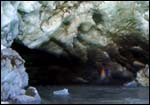


|
|
 |
| HOME | TRAVEL | TRAVELOG | ||

In the Footsteps of the Pandavas ... beyond Badrinath Photographs and text: Nilesh Korgaonkar
But only few will travel beyond the Badrinath to to seek and enjoy the magnificent beauty of the valleys ahead All of these popular pilgrimage spots, set as they are in the rugged, upper reaches of the Himalayas, have more than simply religion to offer. Legend has it that the Pandavas on their journey to heaven passed through the Badrinath valley. The valley has been carved out of this young mountain range by the Alaknanda river. And on a journey beyond Badrinath, the river is your a constant companion by the side of the road; sometimes close by, and at times frighteningly, yet tantalisingly far below.
The mythical indications that the Pandavas had been here and crossed over to some land perhaps over the rainbow are almost immediately visible. High on a hill to the left of the river, a ribbon of water suddenly seems to spring out of the hillside. If you make it a point to enquire about the name of its source, the locals will tell you that the water began to spout from there, after Arjun shot a bow into the hill side to quench the thirst of Draupadi!
Mana -- a strange, interesting village -- is worth visiting. The way Mana-ites go about their everyday life is charming to observe. The folks here claim to be direct descendants of those villagers who in the good old days maintained a trade route with the Tibetans through the Mana Pass on the border with Tibet, a gruelling three-day march away. There is a cave nearby where Rishi Vyas is supposed to have written the Ramayan. The Pandavas probably passed this way centuries before this village was born. A little ahead of Mana is the spot where they allegedly crossed the Saraswati river. At this point the river flows through a deep gorge with the freezing waters plunging over rocks smooth from centuries of polishing. The gorge is a narrow and the river tumbles down with a tremendous roar.
Trekking your way up to this point it is uncomplicated; easy going for just about anyone. But mythology says that the Pandavas carried on beyond on their journey along the Alaknanda. To follow in their footsteps requires a bit of will power and planning. But it is well worth the effort. In fact this one day trek can be very rewarding both physically and spiritually. But due to the proximity of the border with Tibet, it is advisable to obtain permission to venture beyond from the local intelligence bureau detachment at Mana. It is also better to start early in the day to be able to return by early afternoon. And don't forget to carry some food and warm clothing because there is no habitation ahead of Mana.
Draupadi, they say, was the first to fall and she breathed her last just after having crossed the Saraswati. A temple in her name stands here. There is no one looking after the shrine. But the spot offers a wonderful view of the Alaknanda disappearing below the glacier from where it emerges. The path of the Pandavas as it meanders towards the Vasundhara falls, where it finally ends, can also be seen.
One is now trekking at 9,000 ft above sea level. The journey ends at the base of the falls. Venturing beyond means entering the realms of mountaineering. In late October the area resembles the freezer of non-frost-free fridge. The spray of water from the stream freezes on the rocky surface. The Pandavas are supposed to have bathed here before continuing onwards. The Alaknanda valley turns to the northwest and after crossing over some seemingly impregnable ranges continues to the base of the mythical Meru Parbat. Only Yudhistir of the five Pandavas and his faithful dog managed to reach this point and then ascend to heaven.
|
|
|
Fast Facts
|
|
|
|
|
|
HOME |
NEWS |
BUSINESS |
CRICKET |
MOVIES |
CHAT
INFOTECH | TRAVEL | LIFE/STYLE | FREEDOM | FEEDBACK |
|